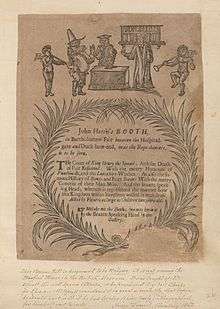Bartholomew Fair
.jpg)
The Bartholomew Fair was one of London's pre-eminent summer Charter fairs. A charter for the fair was granted to Rahere by Henry I to fund the Priory of St Bartholomew; and from 1133 to 1855 it took place each year on 24 August within the precincts of the Priory at West Smithfield, outside Aldersgate of the City of London.[1] The fair continued, after the Dissolution within the Liberty of the parish of St Bartholomew-the-Great.

Whereas the fair was chartered to be a three-day event, it would last a full two weeks in the 17th century; but in 1691, it was shortened to only four days.[1] With a change in the calendar, the fair commenced on 3 September from 1753.[2] A trading event for cloth and other goods as well as a pleasure fair, the event drew crowds from all classes of English society.[3][4]
It was customary for the Lord Mayor of London to open the fair on St Bartholomew's Eve. The Mayor would stop at Newgate Prison to accept a cup of sack (fortified white wine) from the governor.[1][2] The Merchant Taylors Guild processed to Cloth Fair to test the measures for cloth, using their standard silver yard, until 1854. The annual fair grew to become the chief cloth sale in the kingdom.[2]
By 1641, the fair had achieved international importance. It had outgrown the former location along Cloth Fair, and around the Priory graveyard to now cover four parishes: Christ Church, Great and Little St Bartholomew’s and St Sepulchre’s. The fair featured sideshows, prize-fighters, musicians, wire-walkers, acrobats, puppets, freaks and wild animals.[2]
The fair was suppressed in 1855 by the City authorities for encouraging debauchery and public disorder.[2][5] The Newgate Calendar had denounced the fair as a "school of vice which has initiated more youth into the habits of villainy than Newgate itself."[6]
The Bartholomew Fair of 1845 features as the primary location of The Wireless Theatre Company's "The Carnival Of Horrors", the second episode of "The Springheel Saga, Series Two: The Legend of Springheel'd Jack".[7]
References
- 1 2 3 Chisholm 1911.
- 1 2 3 4 5 City of London. "Smithfield Market" (PDF). Archived (PDF) from the original on 27 March 2009. Retrieved 2009-03-23.
- ↑ Morley, Henry (1859). Memoirs of Bartholomew Fair. London. ISBN 1-4437-4944-3.
- ↑ Walford, Cornelius (1883). Fairs, Past and Present. pp. 164–244. ISBN 0-8337-3668-X.
- ↑ Cavendish, Richard (2005). "London's Last Bartholomew Fair: September 3rd, 1855". History Today. 55 (9): 52.
- ↑ Knapp, Andrew; Baldwin, William (1825). The Newgate Calendar. 2. London: J. Robins & Co. p. 15. Retrieved 30 July 2014.
- ↑ "THE LEGEND OF SPRINGHEEL'D JACK, Series Two, Episode Two". Yes. Retrieved 11 March 2014.
- Attribution
-
 Chisholm, Hugh, ed. (1911). "Bartholomew Fair". Encyclopædia Britannica. 3 (11th ed.). Cambridge University Press.
Chisholm, Hugh, ed. (1911). "Bartholomew Fair". Encyclopædia Britannica. 3 (11th ed.). Cambridge University Press.
External links
![]() This article incorporates text from a publication now in the public domain: Chisholm, Hugh, ed. (1911). "Bartholomew Fair". Encyclopædia Britannica (11th ed.). Cambridge University Press.
Coordinates: 51°31.1′N 0°6′W / 51.5183°N 0.100°W
This article incorporates text from a publication now in the public domain: Chisholm, Hugh, ed. (1911). "Bartholomew Fair". Encyclopædia Britannica (11th ed.). Cambridge University Press.
Coordinates: 51°31.1′N 0°6′W / 51.5183°N 0.100°W